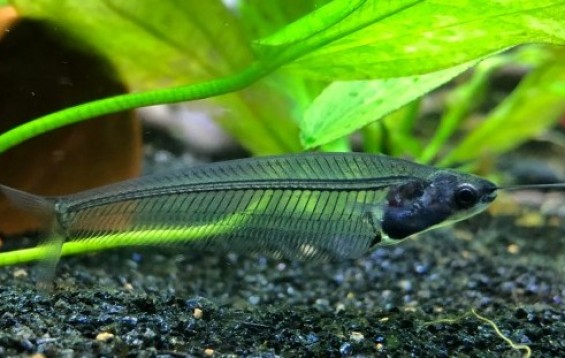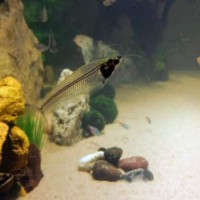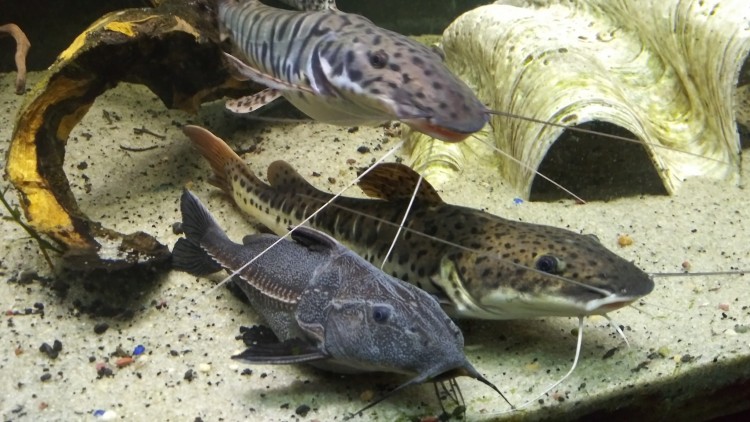- Name:
Ghost Glass Cat
(View AKA's) - Family: Siluridae
- Species: Catfish
- Scientific Name: Kryptopterus Vitreolus



More Details
General info about Ghost Glass Cat
The Ghost Glass Cat, also known as the Glass Catfish or Phantom Catfish, is a small freshwater fish that belongs to the family Siluridae. It has a transparent body that allows you to see its internal organs, bones and other structures. The fish has a long, slender body with a rounded belly and a pointed head. It has no scales, and its skin is very thin and delicate. The Ghost Glass Cat has two pairs of barbels, one on its upper jaw and one on its lower jaw. Its eyes are large and black.
The Ghost Glass Catfish typically grows to about 4 inches (10 cm) in length.
Ghost Glass Cats are peaceful and social fish that are best kept in groups of 5 or more. They are active swimmers and spend most of their time in the mid to upper levels of the water column. They are nocturnal and are most active at night.
The Ghost Glass Cat is a hardy species that is easy to care for. They require a tank with a minimum size of 20 gallons (75 liters) and a fine substrate to prevent injury to their delicate skin. They prefer planted aquariums with plenty of hiding places like driftwood, caves, and tall plants. They are sensitive to high levels of nitrates and should be kept in a well-maintained aquarium with good water quality.
The Ghost Glass Cat is a popular aquarium fish due to its unique transparent appearance. It is also known as the Glass Catfish or Phantom Catfish. The transparent body of the Ghost Glass Cat makes it difficult for predators to spot them in the wild. They are one of the few fish species that can breathe air using a special organ called the labyrinth organ.
Ghost Glass Cat Diet & Nutrition
Ghost Glass Cats are omnivores and feed on a variety of small insects, crustaceans, and algae in the wild. In captivity, they will eat flakes, pellets, frozen or live foods like brine shrimp, bloodworms, and daphnia.
Breeding & Spawning Ghost Glass Cat
Breeding Ghost Glass Cats in captivity can be challenging. They are egg layers and will spawn in pairs or small groups. The eggs are adhesive and stick to plants or other surfaces. Once hatched, the fry can be fed with infusoria and newly hatched brine shrimp.
Ghost Glass Cat Origin
This species is native to Southeast Asia, including Thailand, Indonesia, and Malaysia. They prefer to live in slow-moving, shallow rivers and streams with sandy or muddy substrates. They are also commonly found in rice paddies and flooded fields during the rainy season.
Caution with Ghost Glass Cat
Ghost Glass Cats are generally healthy fish but can be susceptible to some common freshwater diseases like Ich, fin rot, and velvet. They are also sensitive to sudden changes in water parameters and should be acclimated slowly to their new environment.
Relevent Articles
Original Detail
| Name | Species | Family | Scientific Name | More Detail | Added by |
|---|---|---|---|---|---|
| Ghost Glass Cat | Catfish | Siluridae | Kryptopterus Vitreolus | The Ghost Glass Cat, also known as the Glass Catfish or Phantom Catfish, is a small freshwater fish that belongs to the family Siluridae. It has a transparent body that allows you to see its internal organs, bones and other structures. The fish has a long, slender body with a rounded belly and a pointed head. It has no scales, and its skin is very thin and delicate. The Ghost Glass Cat has two pairs of barbels, one on its upper jaw and one on its lower jaw. Its eyes are large and black. The Ghost Glass Catfish typically grows to about 4 inches (10 cm) in length. Ghost Glass Cats are peaceful and social fish that are best kept in groups of 5 or more. They are active swimmers and spend most of their time in the mid to upper levels of the water column. They are nocturnal and are most active at night. The Ghost Glass Cat is a hardy species that is easy to care for. They require a tank with a minimum size of 20 gallons (75 liters) and a fine substrate to prevent injury to their delicate skin. They prefer planted aquariums with plenty of hiding places like driftwood, caves, and tall plants. They are sensitive to high levels of nitrates and should be kept in a well-maintained aquarium with good water quality. The Ghost Glass Cat is a popular aquarium fish due to its unique transparent appearance. It is also known as the Glass Catfish or Phantom Catfish. The transparent body of the Ghost Glass Cat makes it difficult for predators to spot them in the wild. They are one of the few fish species that can breathe air using a special organ called the labyrinth organ. | PalaciosAn |




